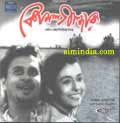 Since its release in 1964, KWAIDAN - an anthology film featuring four separate spooky tales - has earned a reputation in the West as one of the classic Japanese ghost movies. There had been a tradition of such films before, but with its lavish budget and production values, KWAIDAN was not just another routine genre item; it was clearly intended as high-class art.
Since its release in 1964, KWAIDAN - an anthology film featuring four separate spooky tales - has earned a reputation in the West as one of the classic Japanese ghost movies. There had been a tradition of such films before, but with its lavish budget and production values, KWAIDAN was not just another routine genre item; it was clearly intended as high-class art.Click here for TRAILER OF KWAIDAN
Directed by the Japanese master MASAKI KOBAYASHI and Winner of the Special Jury Prize at the 1965 Cannes Film Festival, Kwaidan represents a considerable departure from the works of its director, who made his initial fame with such socially conscious dramas as Black River (a study of corruption brought about by U.S. military bases in Japan) and The Human Condition (an expose of Japanese mistreatment of Chinese in POW camps). Shot almost entirely in enormous studio sets, with a completely post-synched and carefully controlled soundtrack, Kwaidan is about as far from moviemaking realism as it is possible to go. Yet in going to such dramatically ambitious lengths as adapting aspects of Kabuki and Bunaraku puppet theatre to filmmaking techniques, Kobayashi achieves a subtle synthesis of realism and stylization. He makes palpable a vision in which beauty and horror not only coexist but complement one another.
Click here for more on Kwaidan from IMDB
Kwaidan contains four distinct, separate stories
 * In "Black Hair," a faithless samurai abandons his wife for a rich replacement. Later, filled with regret, he returns to his first wife, but he wakes up the next morning to find something else....
* In "Black Hair," a faithless samurai abandons his wife for a rich replacement. Later, filled with regret, he returns to his first wife, but he wakes up the next morning to find something else....* "Woman in the Snow" - features two woodsmen caught in a snow storm. The older one dies at the hands of the title character, a kind of female demon, but she takes pity on the younger, letting him live in exchange for a promise never to reveal what happened.
* "Hoichi the Earless" is about a musician who is summoned to sing his songs about an ancient battle. It turns out his audience consists of the ghosts of those who perished in the battle. A priest protects Hoichi by covering his bodies with tattoos that hide him from the spirits.
* "In a Cup of Tea" - the author tells us - is an unfinished fragment of a tale of what befalls someone who drinks a cup of tea with a "soul" in it, leading to ghostly visitations. The film ends with something similar happening to the author...
"Kwaidan" is a symphony of color and sound that is truly past compare. It is also well acted in a technique of Japanese gestures by a large and orderly cast, the most conspicuous and memorable of whom is Katsuo Nakamura as the blind ballad singer. It is a film that commends itself mainly to those viewers who can appreciate rare subtlety and grace.
Masaki KobayashiMasaki Kobayashi is considered one of the great cinematic masters of the Japanese immediate post-war era No one of that generation of filmmakers was affected quite as strongly by the war as Kobayashi. His most acclaimed films are unflinching explorations into the dark side of Japanese culture, the side that drove men to commit gory suicide for the name of honor and commit horrific atrocities in the name of the Emperor. Kobayashi's exacting professionalism makes his films a visually and emotionally power experience.
Born in February, 1916, in Japan's northern-most island Hokkaido, Kobayashi entered prestigious Waseda University in 1933 . Kobayashi eventually left Waseda to enter Shochiku's Ofuna studios. Kobayashi worked as an assistant for a mere eight months before he was drafted and sent to the front in Manchuria. Opposed to the war, which he viewed as senseless, he refused to rise above the position of private. In 1944, he was transferred to the southern Ryukyu Islands, where he witnessed the war's final bloody tumult. There he was captured by the U.S. and held for a year in a detention camp in Okinawa. In the fall of 1946, Kobayashi returned to Shochiku and served for six years as an assistant director under Keisuke Kinoshita.
He garnered international acclaim and a prestigious San Giorgio prize at the Venice Film Festival in 1960 for his Human Condition I: No Greater Love (1958), the first installment of sweeping trilogy about the war. Kobayashi's films brought to life by the masterful performances of Nakadai in such Kobayashi classics as Harakiri (1962), Kwaidan (1964), and Rebellion (1967).With the acclaimed Kwaidan, his first color film, he pushed this emphasis on composition with his expressionistic use of color. Kobayashi died in of a heart attack in 1996.
Screening at Ashwin Hospital Auditorium, Ganapathy , Kovai.
On 01 07 2007 at 5.45 pm
Call 94430 39630 Email konangal@gmail.com








